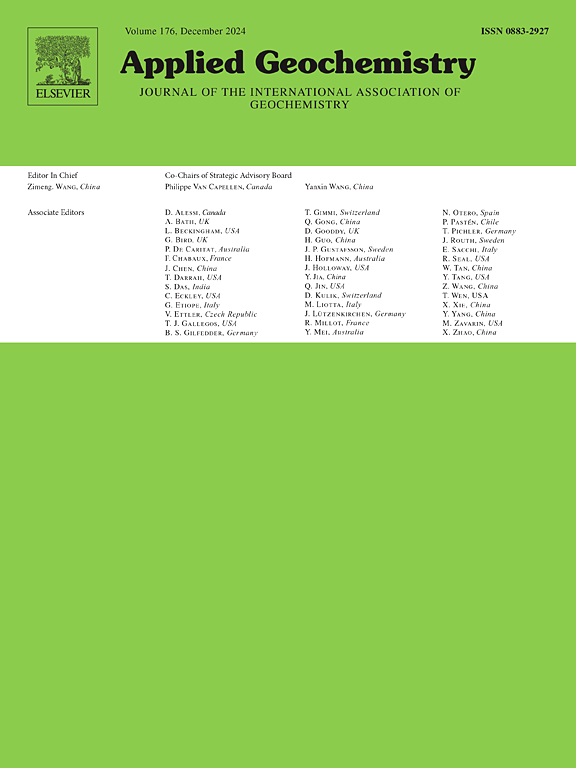Hydrochemistry of a coastal sedimentary basin: evidence from the Lower Kutai Basin, Indonesia
IF 3.4
3区 地球科学
Q1 GEOCHEMISTRY & GEOPHYSICS
引用次数: 0
Abstract
Groundwater is a vital freshwater resource in coastal regions, where 38 % of the global population currently resides. The hydrochemistry of abstracted groundwater in low-lying deltaic regions can pose a risk to human health, especially where monitoring of groundwater quality is limited. This study investigates new evidence of the hydrochemistry of shallow (depths of <250 m) groundwater in the Lower Kutai Basin (LKB) where Indonesia's new capital, Nusantara, is situated. Shallow groundwater is predominantly (67 out of 73 samples) fresh with a median total dissolved solids of 197 mg/L and hydrochemical facies are dominated by the bicarbonate anion. In this coastal sedimentary basin, high concentrations of iron (median = 5.4 mg/L) and manganese (median = 138 μg/L) that exceed WHO drinking-water guidelines reflect widespread reducing conditions in shallow groundwater, promoted by sluggish flow under low hydraulic gradients (primarily <0.002). Stable isotope ratios (δ18O, δ2H) indicate that inland fresh groundwater, traced to heavy rainfall, becomes isotopically heavier and more saline toward the coast. Although the hydrochemical conditions favoring arsenic mobilization mirror those of Asian megadeltas, arsenic concentrations in the shallow groundwater of the LKB are generally low (median = 0.5 μg/L).
沿海沉积盆地的水化学:来自印度尼西亚下库台盆地的证据
地下水是沿海地区的重要淡水资源,目前全球38%的人口居住在沿海地区。在低洼的三角洲地区抽取的地下水的水化学可能对人类健康构成威胁,特别是在地下水质量监测有限的地方。本研究调查了印度尼西亚新首都努沙塔拉所在的下库台盆地(LKB)浅层地下水(深度250米)水化学的新证据。浅层地下水主要是新鲜的(73个样品中有67个),总溶解固体中位数为197 mg/L,水化学相以碳酸氢盐阴离子为主。在这个沿海沉积盆地,铁(中位数= 5.4 mg/L)和锰(中位数= 138 μg/L)的高浓度超过了世卫组织饮用水指南,反映了浅层地下水中普遍存在的还原条件,这是由低水力梯度(主要为<;0.002)下的缓慢流动所促进的。稳定的同位素比值(δ18O和δ2H)表明,内陆淡水在强降雨的作用下,向海岸方向变得同位素更重、更含盐。虽然有利于砷动员的水化学条件与亚洲大三角洲相似,但LKB浅层地下水中的砷浓度普遍较低(中位数= 0.5 μg/L)。
本文章由计算机程序翻译,如有差异,请以英文原文为准。
求助全文
约1分钟内获得全文
求助全文
来源期刊

Applied Geochemistry
地学-地球化学与地球物理
CiteScore
6.10
自引率
8.80%
发文量
272
审稿时长
65 days
期刊介绍:
Applied Geochemistry is an international journal devoted to publication of original research papers, rapid research communications and selected review papers in geochemistry and urban geochemistry which have some practical application to an aspect of human endeavour, such as the preservation of the environment, health, waste disposal and the search for resources. Papers on applications of inorganic, organic and isotope geochemistry and geochemical processes are therefore welcome provided they meet the main criterion. Spatial and temporal monitoring case studies are only of interest to our international readership if they present new ideas of broad application.
Topics covered include: (1) Environmental geochemistry (including natural and anthropogenic aspects, and protection and remediation strategies); (2) Hydrogeochemistry (surface and groundwater); (3) Medical (urban) geochemistry; (4) The search for energy resources (in particular unconventional oil and gas or emerging metal resources); (5) Energy exploitation (in particular geothermal energy and CCS); (6) Upgrading of energy and mineral resources where there is a direct geochemical application; and (7) Waste disposal, including nuclear waste disposal.
 求助内容:
求助内容: 应助结果提醒方式:
应助结果提醒方式:


